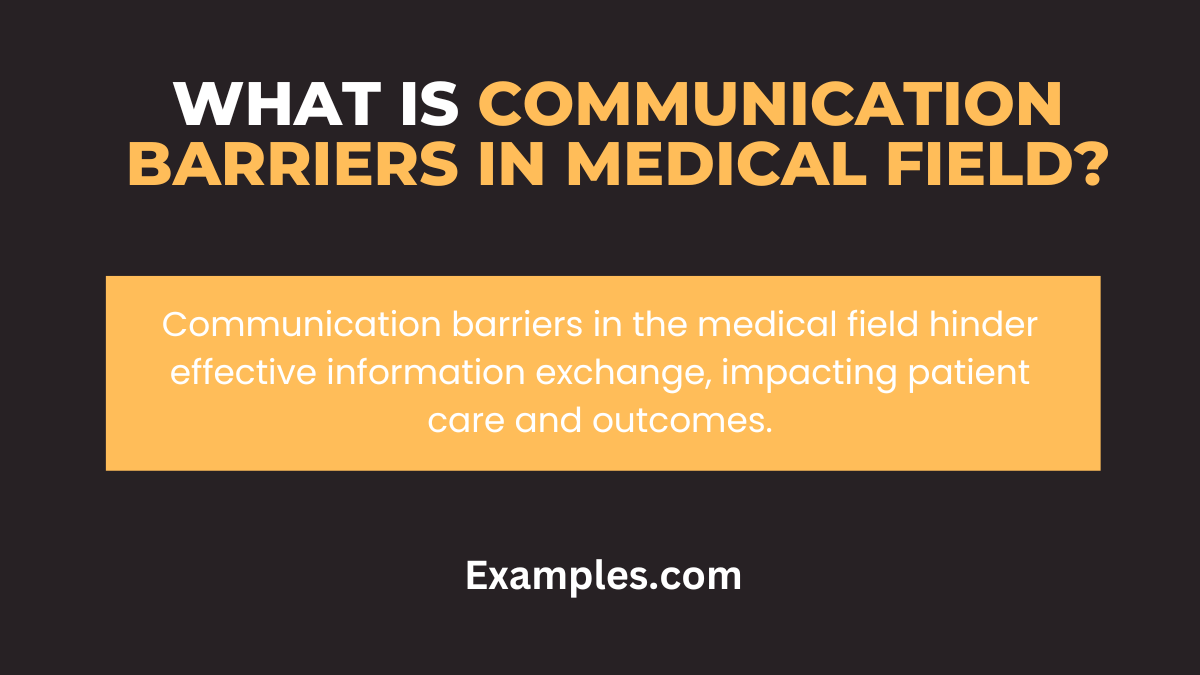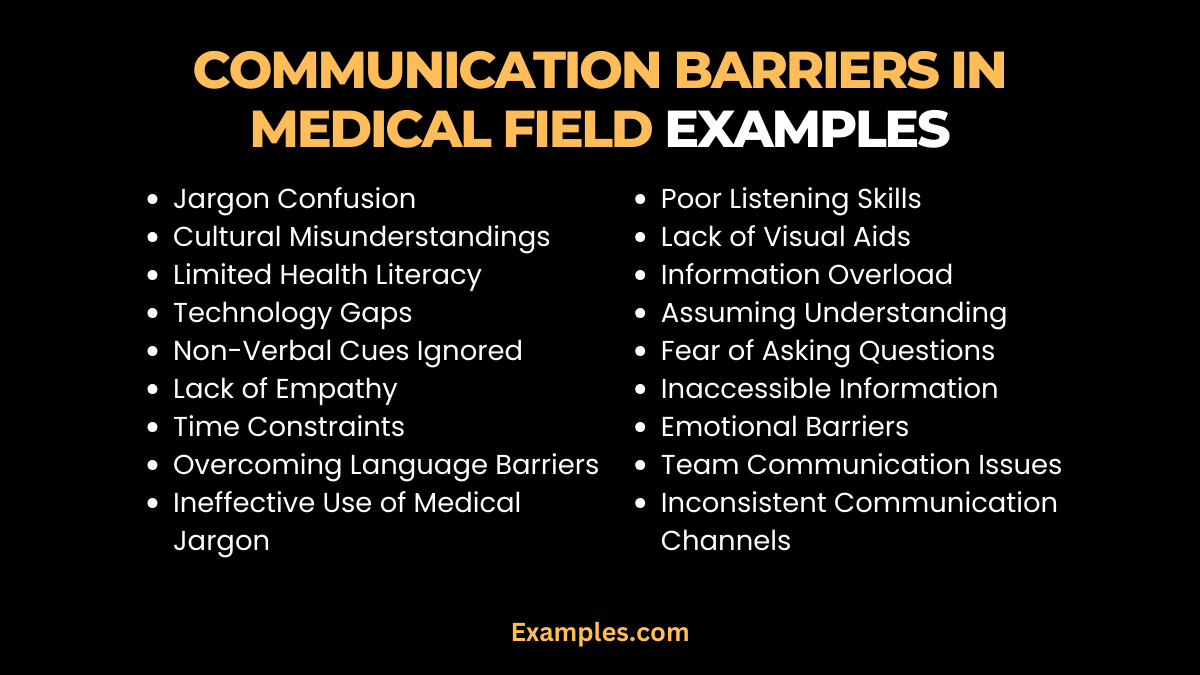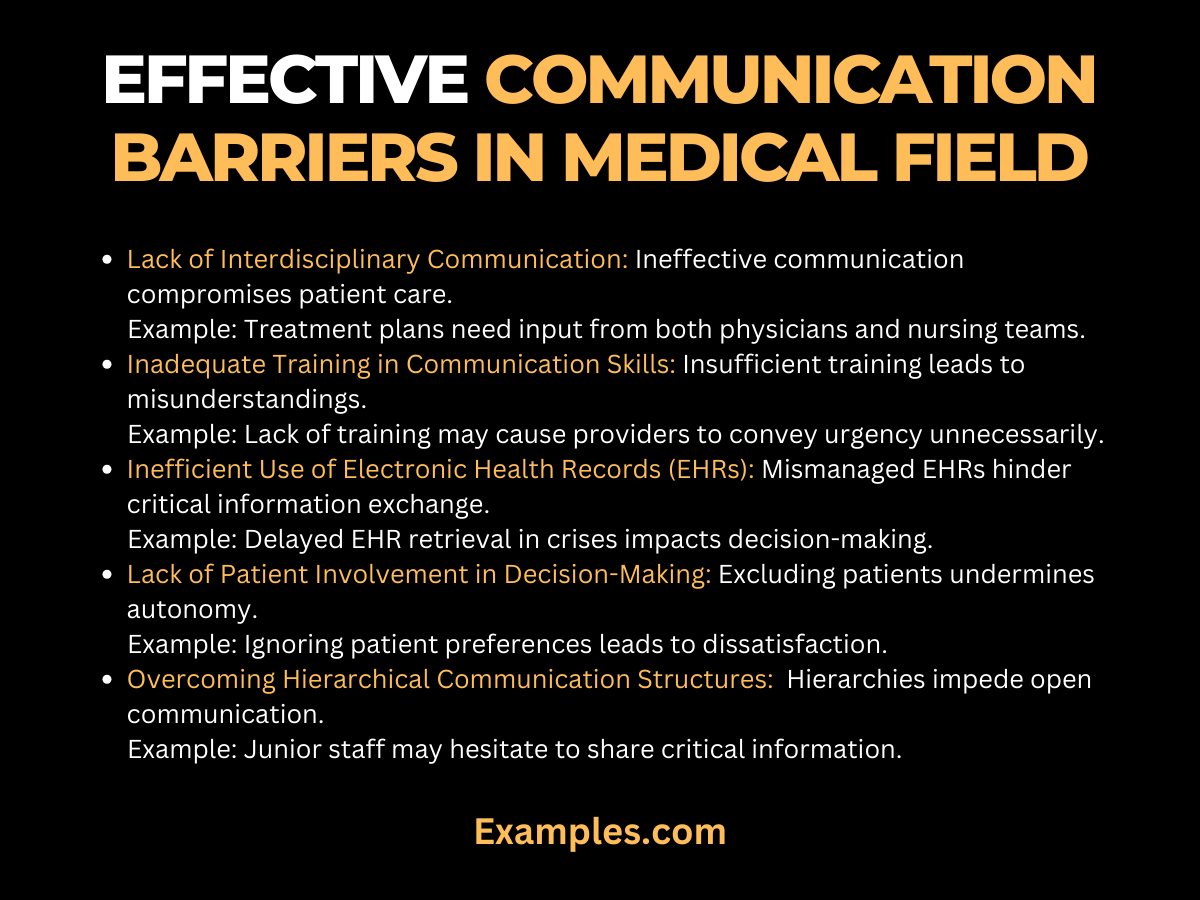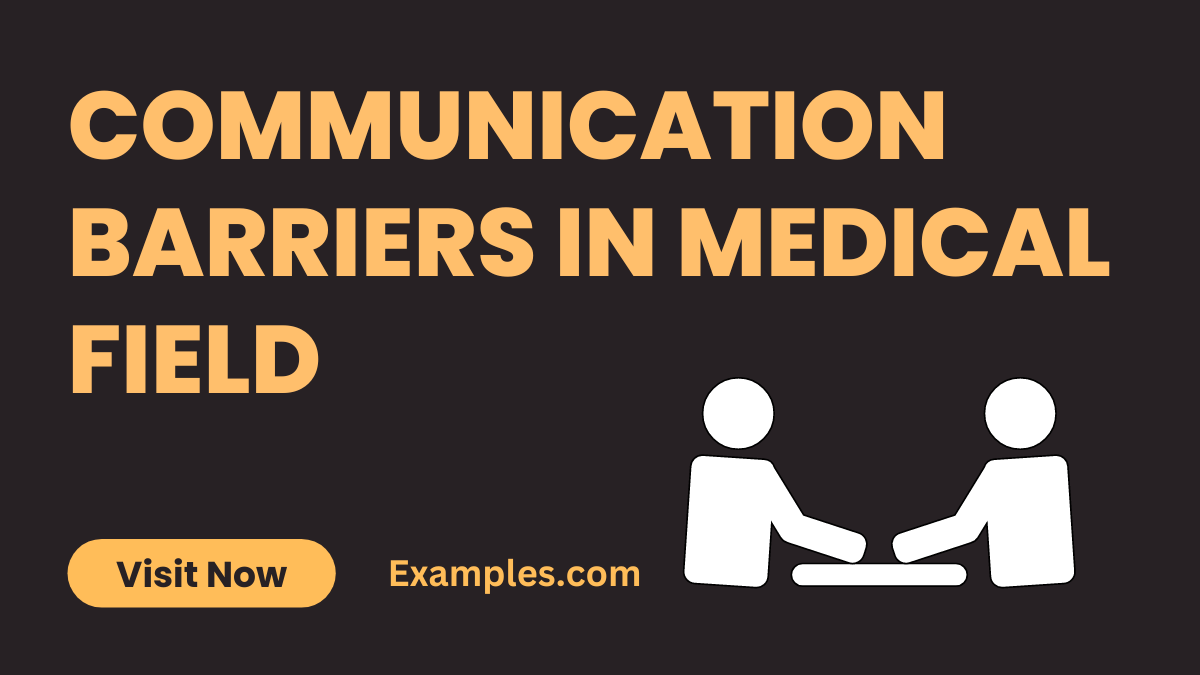19+ Communication Barriers in Medical Field Examples
Unlock the secrets of effective healthcare communication with our comprehensive guide on “Communication Barriers in Medical Field.” In this insightful exploration, discover real-life communication examples and gain valuable insights into overcoming challenges. From enhancing patient-doctor interactions to breaking down language barriers, this guide equips you with practical tips for navigating the complexities of medical communication. Elevate your healthcare communication skills and ensure optimal patient care with our expert guidance.
What is Communication Barriers in Medical Field?

Communication barriers in the medical field refer to obstacles that impede effective information exchange among healthcare professionals, patients, and stakeholders. These hindrances may include language disparities, technological challenges, or misunderstandings. In simple terms, communication barriers can hinder the seamless flow of information crucial for providing optimal healthcare. Understanding these barriers is essential for creating strategies that promote clear, concise, and patient-centered communication in medical settings.
What is the best Example of Communication Barriers in Medical Field?
One prevalent example of communication barriers in the medical field involves language disparities between healthcare providers and patients. This hurdle can lead to misunderstandings, misdiagnoses, and compromised patient care. For instance, when a patient and a medical professional speak different languages, conveying crucial medical information accurately becomes challenging. This communication barrier underscores the need for interpreters, language assistance services, and cultural sensitivity training to ensure effective communication and uphold the quality of healthcare delivery.
20 Communication Barriers in Medical Field Examples:

Navigating the intricacies of healthcare communication is crucial. Here, we delve into 20 distinct examples, shedding light on common barriers and providing insights on how to overcome them.
- Jargon Confusion: Medical professionals using complex terminology can hinder patient understanding. Simplify language for clear comprehension.
- Cultural Misunderstandings: Varied cultural norms impact communication. Be aware of diverse backgrounds to foster effective interactions.
- Limited Health Literacy: Patients may struggle to comprehend medical information. Provide clear, simple explanations for better understanding.
- Technology Gaps: Not all patients are tech-savvy. Ensure alternative communication methods for those unfamiliar with digital platforms.
- Non-Verbal Cues Ignored: Facial expressions matter. Pay attention to patient non-verbal cues to grasp unspoken concerns.
- Lack of Empathy: Patients need emotional support. Show empathy to establish trust and enhance communication.
- Time Constraints: Rushed consultations hinder effective communication. Allocate sufficient time for thorough discussions.
- Overcoming Language Barriers: Provide language assistance for patients with limited English proficiency to ensure accurate information exchange.
- Ineffective Use of Medical Jargon: Simplify medical terms to bridge the communication gap between professionals and patients.
- Mismatched Communication Styles: Adapt your communication style to meet the patient’s needs and preferences.
- Poor Listening Skills: Actively listen to patients to understand their concerns and provide appropriate guidance.
- Lack of Visual Aids: Visual aids enhance understanding. Use diagrams or charts to explain medical concepts.
- Information Overload: Break down complex information into manageable chunks to prevent overwhelming patients.
- Assuming Understanding: Confirm patient comprehension by encouraging questions and clarifications.
- Fear of Asking Questions: Create an open environment where patients feel comfortable asking questions without fear of judgment.
- Inaccessible Information: Ensure medical information is accessible to patients with disabilities for inclusive communication.
- Emotional Barriers: Acknowledge and address emotional barriers, such as fear or anxiety, to facilitate effective communication.
- Team Communication Issues: Collaborate with healthcare teams to streamline communication and ensure comprehensive patient care.
- Inconsistent Communication Channels: Standardize communication channels for consistency in conveying medical information.
- Lack of Follow-Up Communication: Maintain ongoing communication to address post-consultation concerns and ensure continuity of care.
Effective Communication Barriers in Medical Field:

Navigating healthcare communication involves overcoming various barriers. Explore challenges and effective strategies with real-world examples.
- Lack of Interdisciplinary Communication: Ineffective communication compromises patient care.
- Example: Treatment plans need input from both physicians and nursing teams.
- Inadequate Training in Communication Skills: Insufficient training leads to misunderstandings.
- Example: Lack of training may cause providers to convey urgency unnecessarily.
- Inefficient Use of Electronic Health Records (EHRs): Mismanaged EHRs hinder critical information exchange.
- Example: Delayed EHR retrieval in crises impacts decision-making.
- Lack of Patient Involvement in Decision-Making: Excluding patients undermines autonomy.
- Example: Ignoring patient preferences leads to dissatisfaction.
- Overcoming Hierarchical Communication Structures: Hierarchies impede open communication.
- Example: Junior staff may hesitate to share critical information.
- Limited Access to Continuing Education: Stagnant knowledge hinders communication advancements.
- Example: Outdated practices lead to misunderstandings.
- Inadequate Patient Education Materials: Poor materials hamper patient understanding.
- Example: Clear, visually appealing materials are essential for effective communication.
- Reluctance to Seek Clarification: Reluctance leads to errors.
- Example: Providers may proceed with ambiguous instructions.
- Misalignment of Communication Tools: Discordant tools hinder information exchange.
- Example: Standardized platforms ensure consistent information flow.
- Inadequate Cross-Cultural Competence: Lack of cultural awareness leads to misunderstandings.
- Example: Cultural competency training helps navigate diverse communication styles.
Types of Communication Barriers in Medical Field
1. Explore how Environmental Factors Impact Medical Communication. Learn strategies for effective patient interactions amidst distractions.
Examples:Noisy Ward: Use visual aids for clarity amid background noise.
2. Interdepartmental Communication
Uncover challenges from inadequate communication between medical departments. Enhance collaboration for seamless patient care.
Examples:Lab Results Delays: Ensure timely updates between labs and doctors.
3. Inconsistent Documentation
Explore the impact of inconsistent record-keeping on medical communication. Discover strategies for maintaining accurate patient information.
Examples:Incomplete Patient Charts: Encourage thorough documentation to prevent gaps.
4. Patient Privacy Concerns
Delve into challenges arising from privacy concerns. Balance confidentiality with effective information exchange.
Examples:Sensitive Discussions: Establish private spaces for confidentiality.
5. Hierarchical Communication
Examine the impact of hierarchical structures on medical communication. Foster open dialogue for improved teamwork.
Examples:Nurse-Doctor Communication: Promote direct channels for timely updates.
6. Language Complexity in Documentation
Understand how complex language hinders communication. Simplify documentation for interdisciplinary understanding.
Examples:Discharge Summaries: Simplify for clarity in follow-up care.
7. Limited Access to Patient Information
Explore challenges posed by restricted access. Develop strategies for comprehensive access for informed decision-making.
Examples:Cross-Specialty Collaboration: Share patient data among specialties.
8. Inadequate Training on Communication
Address the impact of insufficient training in communication skills. Prioritize ongoing training for patient-centered care.
Examples:Breaking Bad News: Train on delivering sensitive information with empathy.
9. Misalignment of Expectations
Examine how misaligned expectations lead to communication breakdowns. Foster clear communication of roles for cohesive teamwork.
Examples:Patient-Physician Expectations: Align treatment plans with patient expectations.
10. Inadequate Patient Education
Explore the impact of insufficient patient education on communication. Develop strategies for comprehensive patient understanding.
Examples:Medication Regimen Explanation: Use plain language for patient adherence.
What are the Problems with Communication in the Medical Field?
Discover the complexities of communication in healthcare and strategies to overcome barriers.



